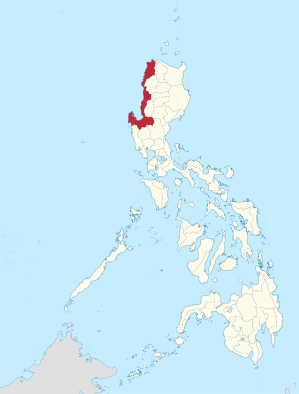Ilocos region
| Ilocos region | |
|---|---|
| Regional center | San Fernando |
| Residents | 5,026,128 |
| - population density | 349.34 per km² |
| surface | 13,013 km² |
| division | |
| - provinces | 4th |
| - cities | 9 |
| - Municipalities | 116 |
| - Barangays | 3,265 |
| languages | Ilokano , Pangasinan , |
The Ilocos Region or Region I ( Ilokano : Rehion ti Ilocos ; Pangasinan : Rihiyon na Sagor na Baybay na Luzon ), also often referred to as Ilocos , is an administrative unit in the Philippines . It is located in the northwest of the country on the main island of Luzon .
The region borders on the Administrative Region of Cordillera and the Cagayan Valley Region to the east and the Central Luzon Region to the south . The administrative center is San Fernando in the province of La Union .
In 2007, 4,545,906 people lived in the 13,013 km² area, resulting in a population density of 349 inhabitants per km². Four different languages are spoken in the region, Ilokano , Pangasinan , Tagalog and English .
People and culture
The region is the historic homeland of the Ilokanos. They form a large majority in the district. In the province of Ilocos Norte , 97% are Ilokanos. It is also more than 90% in the provinces of Ilocos Sur and La Union. In Pangasinan it is only 45%, since the Pangasinans form the majority here. Minorities are the Tingguian and Isneg , who live on the foothills of the Cordilleras . The epic The Life of Lam-Ang , it was written in pre-colonial times, takes place in the Ilocos region.
The population is predominantly Christian with strict supporters of Protestantism , there is also the Independent Philippine Church , a Catholic national church independent of Rome , in the north of the region. The traditional belief in nature also still plays a role, especially in rural areas. The small proportion of Chinese and Indians are mainly Buddhism and Hinduism .
economy
The main industries are agriculture and fishing. In particular the cultivation of rice, tobacco, corn, sugar cane and fruits. Livestock is also farmed, mainly with chickens, goats and water buffalo . Service companies and industrial companies are mostly located in cities. There is a large port in San Fernando and a growing international airport in Laoag .
Tourism focuses on the coastal beaches and ecotourism. Long sandy beaches and the opportunity to practice water sports are given.
Provinces and cities
The Ilocos region is divided into four provinces, which have a total of nine cities:
Provinces: Province, area and inhabitants (as of 2007)
- Ilocos Norte , 3,467.89 km², 547,284
- Ilocos Sur , 2,596.00, 632,255
- La Union , 1,497.70 km², 720,972
- Pangasinan , 5,451.01 km², 2,645,395
Cities:
- Laoag (in Ilocos Norte)
- Vigan (in Ilocos Sur)
- Candon (in Ilocos Sur)
- San Fernando (in La Union)
- Alaminos (in Pangasinan)
- Urdaneta (in Pangasinan)
- Dagupan (in Pangasinan)
- San Carlos (in Pangasinan)
geography
The region is a narrow area between the Philippine Cordilleras and the South China Sea . The Gulf of Lingayen is the most famous body of water in the region and has a large number of islands, most of which are part of the Hundred Islands National Park . The Agno flows through the province of Pangasinan and flows into the Gulf of Lingayen in a wide delta near the cities of Lingayen and Dagupan . Other major rivers in the region are the Laoag , Abra and Amburayan . To the north, the region extends to the Luzonstrasse .
Attractions
Tourist areas and sights are:
- Hundred Islands National Park , which is located in the Gulf of Lingayen,
- the colonial houses of Vigan ,
- Ancient churches , a number of ancient churches in the region.
- The two churches of Nuestra Señora de la Asuncion and San Agustín, which together with the Baroque Churches of the Philippines and the UNESCO World Heritage include
- The Kalbario Patapat National Park in the far north
- The Tirad Pass National Park with the national memorial in honor of Gregorio del Pilar
- The Northern Luzon Heroes Hill National Park with the national memorial in honor of Gabriela Silang
- The Paoay Lake National Park
- The Bessang Pass Natural Monument , with a national memorial
history
The area was originally populated by Negritos before the Malay penetrated their way to the coast through successive waves of immigration. The region was populated by Ilokanos in the north, Pangasinese in the south and Tingguians in the interior. Proud Ilokanos in the north were less influenced, but a deep hatred of Spaniards remained. This hatred has often surfaced as turmoil throughout the history of the region. The most famous uprising occurred in the wake of the British invasion of the Philippines in 1763, led by Diego Silang and his wife Gabriela Silang . Other major uprisings were the Marong uprising (1660–1661), the Palaris uprising (1762–1765) and the Basi putsch in the 19th century .
In 1901 the area was under American colonial rule and in 1941 under Japanese rule. Before the Cordillera Administrative Region was established, the Ilocos region owned the Abra , Mountain Province and Benguet provinces .
Many former presidents of the Philippines come from the region : Elpidio Quirino , Ferdinand Marcos and Fidel Ramos .
Educational institutions
Individual evidence
- ↑ 2015 Population Counts Summary. In: psa.gov.ph. Retrieved June 4, 2016 .
Coordinates: 16 ° 36 ' N , 120 ° 21' E


